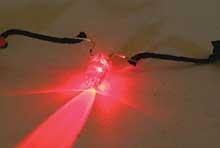Cotton fibres made electrically conductive with nanotube coating
Chinese and US researchers have made cotton fibres conduct electricity by coating them in carbon nanotubes. These ’cotton wires’ feel and behave like ordinary cotton - allowing them to be easily woven into fabrics - and can be modified to detect blood. The research is a step towards futuristic clothing, perhaps capable of monitoring biological functions such as heart beat, perspiration or insulin levels, say the scientists.

’Smart’ textiles are currently being made by incorporating conventional wiring or sensors into fabrics. These technologies are attractive for adding sparkling lights or anti-wrinkle and anti-microbial properties - but they are often uncomfortable to wear, hindered by bulky power supplies, and the fragile optical wiring can be destroyed in a single wash.
’Our fibres have many advantages,’ says Nicholas Kotov, who led the research at the University of Michigan, US. ’They are simple and cheap to prepare and can be easily spun into clothing. Also, they do not feel much different from ordinary cotton and are not itchy.’
The fibres were made by dipping cotton strands - around 1.5mm in diameter - into a solution of nanotubes dispersed in Nafion, an ionic polymer. After repeated dipping and drying, the cotton gradually becomes impregnated with nanotubes - so that even after washing and heating, the nanotubes remain stuck to the strands. The cotton fibres show an electrical resistance of around 20 Ohms per centimetre - low enough for the team to power an LED.
Chuanlai Xu’s team at Jiangnan University then synthesised antibodies that could be integrated into the fibres, giving them the ability to detect blood.
With the price of nanotubes becoming more economical, Xu is investigating other useful roles that the fibres could play. ’We are working on making rapid-detection facilities that could spot toxic residues, for example in food safety environments,’ Xu told Chemistry World .
’What’s most interesting is the promising simplicity of how the nanotubes are applied to the cotton,’ says Ray Baughman, director of the NanoTech Institute at the University of Texas in Dallas, US. ’This results in a very respectable electrical conductivity as well as doubling their tensile strength, which could prove useful for many applications.’
Lewis Brindley
References
B S Shimet al, Nano Lett., 2008, 8, 4151 (DOI: 10.1021/nl801495p)






No comments yet